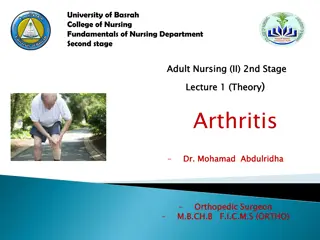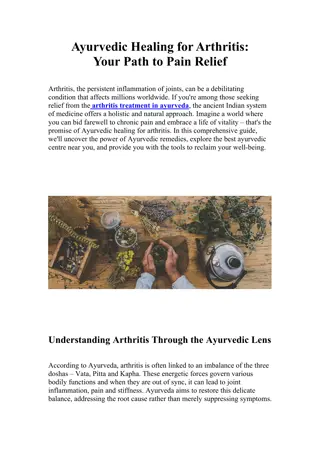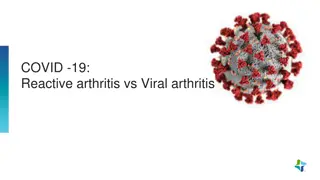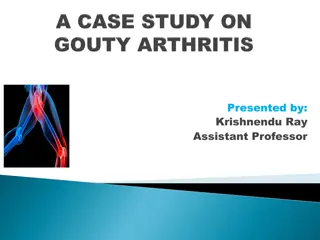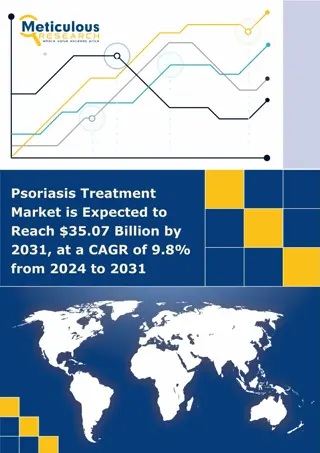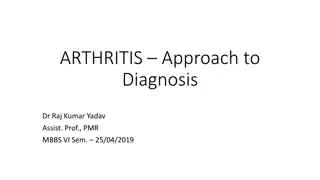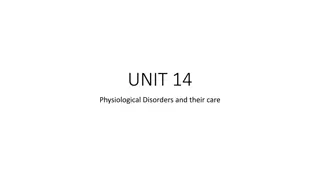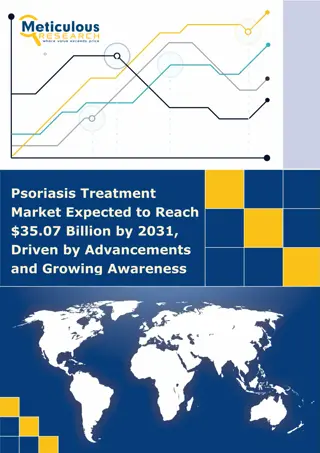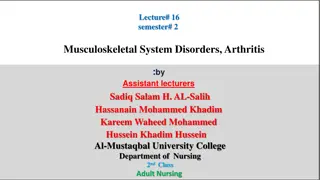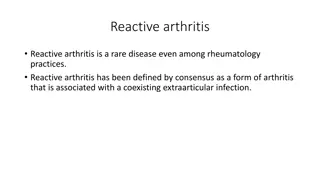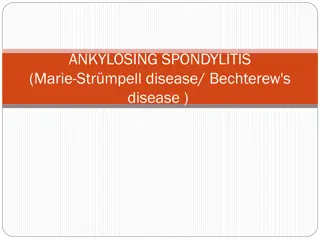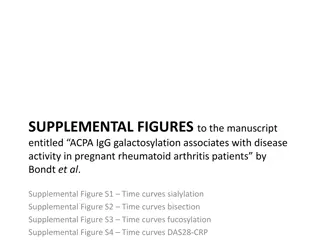Subcutaneous Secukinumab in Psoriatic Arthritis: FUTURE 5 Study Results
The FUTURE 5 study examined the efficacy of subcutaneous secukinumab in inhibiting radiographic progression and improving clinical outcomes in psoriatic arthritis. Results showed significant improvement in ACR20, inhibition of structural damage progression, and resolution of enthesitis and dactylitis with varying dosing regimens. The study highlighted the importance of a loading dose regimen for optimal treatment outcomes, reinforcing the efficacy and safety profile of secukinumab in PsA treatment.
Download Presentation

Please find below an Image/Link to download the presentation.
The content on the website is provided AS IS for your information and personal use only. It may not be sold, licensed, or shared on other websites without obtaining consent from the author.If you encounter any issues during the download, it is possible that the publisher has removed the file from their server.
You are allowed to download the files provided on this website for personal or commercial use, subject to the condition that they are used lawfully. All files are the property of their respective owners.
The content on the website is provided AS IS for your information and personal use only. It may not be sold, licensed, or shared on other websites without obtaining consent from the author.
E N D
Presentation Transcript
Faculty Philip J. Mease, MD Clinical Professor University of Washington School of Medicine Director, Rheumatology Clinical Research Division Swedish Medical Center Seattle, Washington
Subcutaneous Secukinumab Inhibits Radiographic Progression in Psoriatic Arthritis: Primary Results from a Large Randomized, Controlled, Double-Blind Phase 3 Study [abstract] Mease PJ, van der Heijde D, Landew RBM, et al. Arthritis Rheumatol. 2017; 69 (suppl 10). Abstract Abstract
Trial Design and Methods FUTURE 5 study of IL-17 antagonist, secukinumab. N=996 adults with active PsA were randomized to subcutaneous secukinumab with 300 mg and 150 mg, with loading dose regimen of 5 weekly injections, followed by monthly injections; 150 mg without loading dose monthly dosing from baseline; or placebo. Primary endpoint was ACR20 at week 16. Secondary endpoint was radiographically assessed structural damage progression based on hand/wrist/foot X-rays obtained at baseline, at week 16 (nonresponders), and at week 24. Mease PJ, van der Heijde D, Landew RBM, et al. Arthritis Rheumatol. 2017; 69 (suppl 10).
Key Findings Secukinumab significantly improved ACR20 at week 16 vs placebo. Radiographic progression was significantly inhibited at week 24 in all secukinumab arms vs placebo. Enthesitis and dactylitis resolution showed significant improvement in the secukinumab dose arms with a loading regimen compared to placebo. The best effect in key endpoints was achieved utilizing the loading dose regimen. Safety profile was consistent with previously reported, with no new safety signals identified. Mease PJ, van der Heijde D, Landew RBM, et al. Arthritis Rheumatol. 2017; 69 (suppl 10).
Faculty Commentary This FUTURE 5 study is the largest randomized controlled trial (n=996) of a biologic conducted to date in psoriatic arthritis (PsA). It shows the subcutaneous loading-dose method of secukinumab inhibits progression of structural damage progress. This trial addressed whether having a 5-weekly loading dose is helpful. The outcome with loading dose was slightly better in several key clinical domains. This study is consistent with previous trials; it is now a popularly used drug that can be used with confidence regarding efficacy and safety.
Secukinumab Achievement of Psoriatic Arthritis Disease Activity Score (PASDAS) Related Remission: 2-Year Results from a Phase 3 Study [abstract] Coates LC, Gladman DD, Nash P, et al. Arthritis Rheumatol. 2017; 69 (suppl 10). Abstract Abstract
Trial Design & Methods This post hoc analysis of FUTURE 2 study assessed the ability of the IL-17 antagonist, secukinumab, to achieve low-disease activity or remission using PASDAS through 104 weeks. PASDAS was assessed in overall population and in patients stratified by prior anti-TNF use and disease duration ( 2 years vs >2 years since first PsA diagnosis). The PASDAS index is derived from physician global visual analogue scale (VAS), patient global VAS taking in both arthritis and skin disease impact with cut-points for high disease activity (HDA 5.4), moderate (3.2< MoDA <5.4), low (1.9< LDA 3.2), and remission ( 1.9.3). Coates LC, Gladman DD, Nash P, et al. Arthritis Rheumatol. 2017; 69 (suppl 10).
Key Findings PASDAS remission and low-disease activity were achieved in 38.5% and 34.4% of patients treated with secukinumab 300 mg and 150 mg, respectively, vs 16.1% in placebo group at week 16. Secukinumab-treated patients achieving PASDAS remission had significantly greater improvements in function, quality of life, and fatigue. This study shows the holistic, continuous measure specific for PsA is being used increasingly in trials and shows good utility. Coates LC, Gladman DD, Nash P, et al. Arthritis Rheumatol. 2017; 69 (suppl 10).
Faculty Commentary This study focuses on the measurement and the quantitation of disease activity. PASDAS worked well as a composite index to measure disease activity and is a worthy and reliable holistic measure for use in clinical trials to measure PsA. The thresholds of remission and low-disease rate were met by approximately 1/3 of the patients in treatment groups at week 16. The long-term observation was also positive: by week 104, 50% were in PASDAS state of low-disease activity. Psoriatic Arthritis Disease Activity Score (PASDAS)
Secukinumab Demonstrates Consistent Safety over Long-Term Exposure in Patients with Psoriatic Arthritis and Moderate to Severe Plaque Psoriasis: Updated Pooled Safety Analyses [abstract] Mease PJ, McInnes LB, Reich K, et al. Arthritis Rheumatol. 2017; 69 (suppl 10). Abstract Abstract
Trial Design and Methods This trial reported updates on longer term safety data of secukinumab exposure from pooled data of psoriasis and psoriatic arthritis studies. Results derived from pooled psoriasis data from 9 phase 3 studies in moderate-to-severe plaque psoriasis (n=3893) and pooled data from 3 phase 3 studies in active PsA (n=1380) Placebo patients were re-randomized to secukinumab at 12 24 weeks depending on study design. PTH, parathyroid hormone; IV, intravenously. Mease PJ, McInnes LB, Reich K, et al. Arthritis Rheumatol. 2017; 69 (suppl 10).
Key Findings Serious adverse events for PsA patients were as follows: Serious infections, 1.7% Candida infections, 1.7% Inflammatory bowel disease, 0.4% Crohn s disease and ulcerative colitis, each 0.1% Major adverse cardiac event, 0.4%. Safety was comparable across psoriasis and PsA patients supporting long-term use in these chronic conditions. Mease PJ, McInnes LB, Reich K, et al. Arthritis Rheumatol. 2017; 69 (suppl 10).
Faculty Commentary This is the largest compilation of safety data to date for secukinumab in psoriasis and PsA, with results that reliably teach us about safety in a large population of patients. The safety outcomes were similar between patients who only have psoriasis and those with the broader impact of PsA, in which musculoskeletal manifestations exist. Although secukinumab slightly increases the rate of serious infection, as is expected from a biologic agent, we see the frequency of such infections is low. There was a small signal for either recurrent IBD in patients with known IBD, or new occurrence. Fortunately, the rate was small. It is not known if this is due to the agent not protecting against such an occurrence or possibly facilitating it. This study supports secukinumab can be used with confidence regarding safety in patients with psoriasis and PsA. Note that I avoid use in patients with active IBD.
Ixekizumab Exhibits a Favorable Safety Profile during 24 Weeks of Treatment in Subjects with Active Psoriatic Arthritis: Integrated Safety Analysis of Two Randomized, Placebo Controlled, Phase III Clinical Trials [abstract] Mease PJ, Burmester GR, Moriarty S, et al. Arthritis Rheumatol. 2017; 69 (suppl 10). Abstract Abstract
Trial Design and Methods Study of the most recently FDA-approved (December 2017) IL-17 antagonist, ixekizumab, for PsA. N=678 adults with active PsA randomized to 80 mg ixekizumab every 4 weeks (Q4W, n=229) or 2 weeks (Q2W, n=225) after a 160-mg starting dose or placebo (n=224). Primary outcome: integrated safety of 2 pivotal trials in patients with active PsA. Mease PJ, Burmester GR, Moriarty S, et al. Arthritis Rheumatol. 2017; 69 (suppl 10).
Key Findings No clear difference between groups for the percentage of patients with 1 serious adverse event or discontinued early from study drug. Infection-related serious adverse events low: 1% (total IXE, n=454) vs 0 in placebo (n=224) Rate of Candida infection slightly higher in IXE (3%) than placebo (<1%) No Crohn s disease or ulcerative colitis No specific malignancy signaled. Rate of malignancy was low (<1%) No signal of suicidal ideation Safety profile of ixekizumab consistent with published findings in patients receiving ixekizumab for moderate-to-severe plaque psoriasis Mease PJ, Burmester GR, Moriarty S, et al. Arthritis Rheumatol. 2017; 69 (suppl 10).
Faculty Commentary This study showed a range of serious adverse events of 1.5% to 2.5%, which is relatively low compared to many other trials of biologic agents. Although not head-to-head trials, the overall rate of serious infection is less than observed in trials of TNF inhibitors. Clinicians, however, should speak to their patients about the risk, even while understanding that the potential for serious infection is low. These study results underline the point that IL-17 inhibitors seem to be overall quite safe and can be used with confidence from this perspective.
Efficacy and Safety Results from a Phase 2 Trial of Risankizumab, a Selective IL-23p19 Inhibitor, in Patients with Active Psoriatic Arthritis [abstract] Mease PJ, Kellner H, Morita A, et al. Arthritis Rheumatol. 2017; 69 (suppl 10). Abstract Abstract
Trial Design and Methods Five-arm study, n=185 patients with active PsA were randomized to receive risankizumab in an ongoing double-blind, parallel-design, dose-ranging phase 2 study: 150 mg at weeks 0, 4, 8, 12, and 16 (arm 1) 150 mg at weeks 0, 4, and 16 (arm 2) 150 mg at weeks 0 and 12 (arm 3) 75-mg single dose at week 0 (arm 4) or matching placebo (arm 5) Patients were stratified at randomization by prior tumor necrosis factor inhibitor (TNFi) use and concurrent methotrexate use. Mease PJ, Kellner H, Morita A, et al. Arthritis Rheumatol. 2017; 69 (suppl 10).
Key Findings At week 16, ACR20 responses were significantly greater in patients receiving risankizumab (across all arms, 57.1% 65.0%) compared with placebo (37.5%) ACR50 responses were numerically higher. At week 16, risankizumab-treated patients achieved significantly higher ACR70 and minimal disease activity responses, as well as greater improvements in DAS28(CRP) and Pain-VAS. Treatment-emergent adverse events were comparable across treatment arms; the most common was infection. Mease PJ, Kellner H, Morita A, et al. Arthritis Rheumatol. 2017; 69 (suppl 10).
Faculty Commentary Risankizumab (not yet FDA approved) is 1 of 3 pure IL-23 inhibitors advancing in psoriasis and PsA. These agents work by interacting with the p19 subunit of IL-23 motility molecule, preventing receptor activation and thereby disrupting the IL-23/IL-17 axis. This trial is the first demonstration of risankizumab effectiveness in PsA, with multiple arms studying different dose frequency regimens. All doses and dose frequencies worked equally well, including the 75-mg dose in the week 0 arm. Effective demonstrating ACR20 response, with very good skin responses, as well as a good safety profile. IL-23 inhibition is an appropriate target in the management of psoriasis and PsA. This study provides clinicians confidence in its use, as this agent moves into phase 3.
Ustekinumab Is Superior to TNF Inhibitor Treatment in Resolving Enthesitis in PsA Patients with Active Enthesitis-Results from the Enthesial Clearance in Psoriatic Arthritis Study [abstract] Araujo EG, Englbrecht M, Hoepken S, et al. Arthritis Rheumatol. 2017; 69 (suppl 10). Abstract Abstract
Trial Design and Methods Ustekinumab is an IL-12/23, FDA approved for PsA in 2013. This study provides a statistical response to the pathway of the IL-23, highlighting the enthesitis response, and compares the efficacy of ustekinumab with tumor necrosis factor inhibitor (TNFi) treatment to clear enthesitis in PsA patients. Patients with PsA and active enthesitis were enrolled 1:1, receiving either standard doses of ustekinumab (arm 1; n=23) or TNFi (arm 2; n=24). Primary endpoint was a SPARCC of 0 after 6 months. Araujo EG, Englbrecht M, Hoepken S, et al. Arthritis Rheumatol. 2017; 69 (suppl 10).
Key Findings After 6 months, 70.8% UST patients and 38.4% TNFi patients reached the primary endpoint defined as clearance of enthesitis (SPARCC=0). Results suggest UST may be superior to TNFi in resolving the enthesitis component of disease in a population of PsA patients characterized by active enthesial disease. The SPARCC enthesitis scoring system was more discriminative in its ability to show statistically significant response than the Leeds enthesitis index. Araujo EG, Englbrecht M, Hoepken S, et al. Arthritis Rheumatol. 2017; 69 (suppl 10).
Faculty Commentary This study shows SPARC is better used as an enthesitis index. The SPARCC enthesitis index assesses 18 different enthesial sites, which is more discriminative than the Leeds enthesitis index, which measures just 6. Inhibitions of IL-23 axis may be more important than enthesitis (and more than synovitis management) for TNF inhibitors than those working on the IL-17/23 axis. We look forward to future head-to-head trials between drugs in the IL-23/ IL-17 inhibitory pathway and other mechanisms, eg, TNF inhibitors, to see if there is differential effect in the sometimes difficult-to-treat domain of enthesitis.
Safety and Efficacy of Tofacitinib, an Oral Janus Kinase Inhibitor, up to 36 Months in Patients with Active Psoriatic Arthritis: Data from the Second Interim Analysis of OPAL Balance, an Open-Label, Long-Term Extension Study [abstract] Nash P, Coates LC, Kivitz AJ, et al. ArthritisRheumatol. 2017; 69 (suppl 10). Abstract Abstract
Trial Design and Methods Results derived from 36-month, open-label, long-term extension study (ie, OPAL Balance). Eligible patients included from 2 previous pivotal phase 3 tofacitinib PsA studies, OPAL Broaden and OPAL Beyond, comparing tofacitinib 5 mg or 10 mg compared to placebo in active PsA. Dosing continued as either 5 mg or 10 mg based on dosing in the primary studies. After one month, patients in the 5-mg arm were allowed to increase to 10 mg twice a day for efficacy reasons or reduce to 5 mg for safety reasons. Primary endpoints included incidence and severity of adverse events, as well as change from baseline in laboratory values. Secondary endpoint was efficacy. Nash P, Coates LC, Kivitz AJ, et al. Arthritis Rheumatol. 2017; 69 (suppl 10).
Key Findings 67.1% of patients had ACR20 response at 24 months Efficacy was achieved in key secondary endpoints, including enthesitis, dactylitis, skin manifestations of psoriasis, function, and quality of life measures were sustained. 10.5% of patients had serious AEs, and 7.6% discontinued due to AEs 1.6% reported serious infections 2.8% reported herpes zoster events 0.3% reported major adverse cardiovascular events 1.9% reported malignancies No AEs of gastrointestinal perforation or inflammatory bowel disease reported Nash P, Coates LC, Kivitz AJ, et al. Arthritis Rheumatol. 2017; 69 (suppl 10).
Faculty Commentary Study showed a low rate (1.6%) of serious infections. Over 36 months, the safety profile of tofacitinib was similar to the pivotal phase 3 OPAL studies, as well as previous trials in rheumatoid arthritis. No new or different emerging adverse events were identified. These results support the sustained efficacy and relative safety of tofacitinib in PsA.


